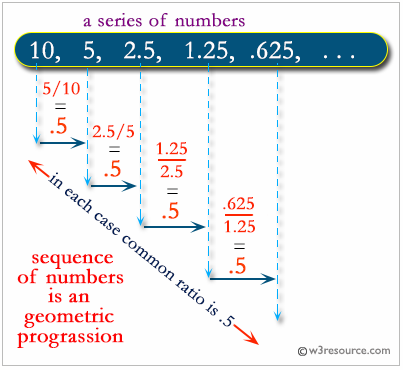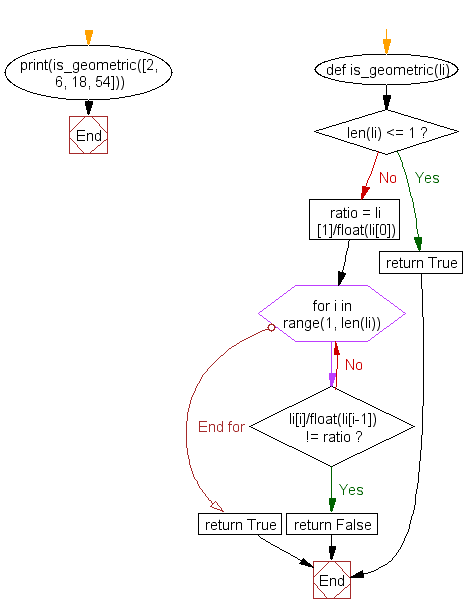Python Challenges: Check a sequence of numbers is a geometric progression or not
Python Challenges - 1: Exercise-21 with Solution
Write a Python program to check a sequence of numbers is a geometric progression or not.
In mathematics, a geometric progression or geometric sequence is a sequence of numbers where each term after the first is found by multiplying the previous one by a fixed, non-zero number called the common ratio.
For example, the sequence 2, 6, 18, 54, ... is a geometric progression with common ratio 3. Similarly, 10, 5, 2.5, 1.25, ... is a geometric sequence with common ratio 1/2.
Explanation:

Sample Solution:-
Python Code:
def is_geometric(li):
if len(li) <= 1:
return True
# Calculate ratio
ratio = li[1]/float(li[0])
# Check the ratio of the remaining
for i in range(1, len(li)):
if li[i]/float(li[i-1]) != ratio:
return False
return True
print(is_geometric([2, 6, 18, 54]))
print(is_geometric([10, 5, 2.5, 1.25]))
print(is_geometric([5, 8, 9, 11]))
Sample Output:
True True False
Flowchart:

Visualize Python code execution:
The following tool visualize what the computer is doing step-by-step as it executes the said program:
Python Code Editor:
Contribute your code and comments through Disqus.
Previous: Write a Python program to check a sequence of numbers is an arithmetic progression or not.
Next: Write a Python program to compute the sum of the two reversed numbers and display the sum in reversed form.
What is the difficulty level of this exercise?
Test your Programming skills with w3resource's quiz.
Python: Tips of the Day
Find current directory and file's directory:
To get the full path to the directory a Python file is contained in, write this in that file:
import os dir_path = os.path.dirname(os.path.realpath(__file__))
(Note that the incantation above won't work if you've already used os.chdir() to change your current working directory, since the value of the __file__ constant is relative to the current working directory and is not changed by an os.chdir() call.)
To get the current working directory use
import os cwd = os.getcwd()
Documentation references for the modules, constants and functions used above:
- The os and os.path modules.
- The __file__ constant
- os.path.realpath(path) (returns "the canonical path of the specified filename, eliminating any symbolic links encountered in the path")
- os.path.dirname(path) (returns "the directory name of pathname path")
- os.getcwd() (returns "a string representing the current working directory")
- os.chdir(path) ("change the current working directory to path")
Ref: https://bit.ly/3fy0R6m
- New Content published on w3resource:
- HTML-CSS Practical: Exercises, Practice, Solution
- Java Regular Expression: Exercises, Practice, Solution
- Scala Programming Exercises, Practice, Solution
- Python Itertools exercises
- Python Numpy exercises
- Python GeoPy Package exercises
- Python Pandas exercises
- Python nltk exercises
- Python BeautifulSoup exercises
- Form Template
- Composer - PHP Package Manager
- PHPUnit - PHP Testing
- Laravel - PHP Framework
- Angular - JavaScript Framework
- Vue - JavaScript Framework
- Jest - JavaScript Testing Framework
